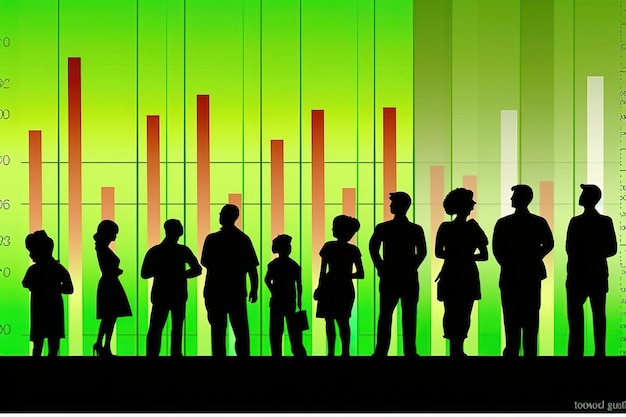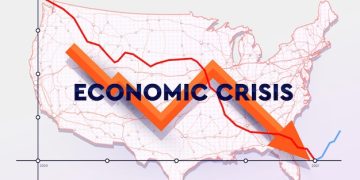Key US Economic Indicators to Watch in Second Half of 2025

Several key economic indicators will shape the US economic landscape in the second half of 2025, including inflation rates, GDP growth, employment figures, consumer spending, and Federal Reserve policy decisions, all of which investors and policymakers must monitor closely to navigate potential shifts and opportunities.
Monitoring the US economy involves keeping a close eye on several key indicators. As we move into the second half of 2025, it’s essential to know what are the key economic indicators to watch for in the second half of 2025, so you can make informed decisions about investments and financial planning.
Understanding the Economic Landscape of H2 2025
The economic outlook for the second half of 2025 is expected to be multifaceted, influenced by both domestic and global factors. Analyzing key economic indicators provides crucial insights into the trajectory of the US economy.
These indicators serve as barometers, reflecting the health and stability of various sectors. By staying informed and closely monitoring these metrics, businesses, investors, and policymakers can better navigate the dynamic economic environment.
Factors Influencing Economic Predictions
Several factors play a significant role in shaping economic predictions. Understanding these underlying forces is crucial for interpreting economic indicators accurately.
- Geopolitical events can trigger volatility in markets and affect trade relationships.
- Technological advancements drive productivity and innovation, influencing long-term growth.
- Changes in consumer behavior and confidence impact spending patterns and economic activity.
- Government policies, including fiscal and monetary measures, can stimulate or restrain economic growth.
Keeping these factors in mind allows for a more holistic understanding of the economic indicators you’re watching. This approach enhances the ability to forecast potential trends and make well-informed decisions.
Inflation Rates: A Critical Indicator
Inflation remains a primary concern for economists and consumers alike. Understanding inflation rates is crucial for assessing the purchasing power and overall economic stability.
Monitoring inflation trends enables better planning and investment decisions. Keeping a pulse on inflation allows for adjustments in financial strategies to mitigate potential adverse effects.

Key Inflation Metrics
Several metrics provide insight into inflation rates. Each measurement offers unique perspectives on the price levels within the economy.
- The Consumer Price Index (CPI) measures changes in the price of a basket of goods and services purchased by households.
- The Producer Price Index (PPI) tracks changes in prices received by domestic producers for their output.
- The Personal Consumption Expenditures (PCE) price index reflects the prices of goods and services purchased by individuals.
- Core inflation rates, excluding volatile food and energy prices, provide a clearer picture of underlying inflation trends.
Tracking these metrics collectively provides a comprehensive understanding of inflation dynamics and their impact on the US economy.
GDP Growth: Gauging Economic Expansion
Gross Domestic Product (GDP) is the broadest measure of economic activity, representing the total value of goods and services produced in the United States. Monitoring GDP growth provides insights into whether the economy is expanding or contracting.
Economists and investors closely watch GDP figures to assess the overall health of the economy. Sustained GDP growth typically indicates a robust and thriving economic environment.
Factors Contributing to GDP Growth
Several factors can contribute to GDP growth. Understanding these elements helps to assess the sustainability of economic expansion.
Consumer spending is a major driver of GDP growth, reflecting the demand for goods and services. Business investment in new equipment, technology, and facilities also boosts economic activity.
Government spending on infrastructure, defense, and social programs contributes to GDP growth. A favorable trade balance, with exports exceeding imports, adds to the overall GDP.
Technological innovation and productivity improvements also play a role in driving long-term GDP growth.
By examining these factors, one can gain deeper insights into the underlying drivers of GDP growth and potential future economic trends.
Employment Figures: Assessing Labor Market Health
Employment figures serve as a critical barometer of the labor market’s health. The unemployment rate, job creation, and labor force participation rates are key indicators.
A strong labor market generally translates to higher consumer confidence and spending. Robust employment figures often indicate a healthy and expanding economy.

Understanding Key Employment Metrics
Analyzing various employment metrics provides a detailed view of the labor market. Each metric offers unique insights into the employment landscape.
- The unemployment rate measures the percentage of the labor force that is unemployed and actively seeking work.
- Job creation figures reflect the number of new jobs added to the economy each month.
- The labor force participation rate indicates the percentage of the population that is either employed or actively seeking employment.
- Average hourly earnings provide insight into wage growth and inflationary pressures.
Monitoring these metrics helps to understand the overall strength and resilience of the US labor market.
Consumer Spending: A Driver of Economic Activity
Consumer spending is a key driver of economic activity, accounting for a significant portion of the US GDP. Tracking consumer spending patterns provides valuable insights into the health of the economy.
Changes in consumer spending can reflect shifts in consumer confidence and economic expectations. Rising consumer spending typically indicates optimism and a willingness to invest in the economy.
Factors Influencing Consumer Spending
Several factors influence consumer spending patterns. Understanding these variables is crucial for accurately interpreting spending trends.
Consumer confidence, influenced by economic conditions and job security, impacts spending decisions. Disposable income, determined by wages and taxes, affects the amount consumers have available to spend.
Interest rates on loans and credit cards can either encourage or discourage spending. Major purchases, like homes and vehicles, often drive significant shifts in consumer spending.
By observing these factors, economists and analysts can better understand the drivers behind consumer behavior and predict future spending patterns.
Federal Reserve Policy: Steering the Economic Course
The Federal Reserve plays a crucial role in steering the economic course through monetary policy. Interest rate adjustments, quantitative easing, and other measures can influence inflation, employment, and economic growth.
Changes in Federal Reserve policy often have significant effects on financial markets and the broader economy. Investors and businesses closely monitor the Fed’s actions and communications.
Key Federal Reserve Tools
The Federal Reserve employs several tools to manage the economy. Understanding these tools helps to interpret the Fed’s actions.
- Adjusting the federal funds rate, the target rate that banks charge each other for overnight lending, is a primary tool.
- Quantitative easing (QE) involves purchasing government bonds and other assets to inject liquidity into the market.
- Forward guidance involves communicating the Fed’s intentions and expectations to influence market behavior.
- Reserve requirements, the percentage of deposits that banks must hold in reserve, can also be adjusted to manage liquidity.
These tools enable the Federal Reserve to influence the money supply and credit conditions, thereby impacting the overall economy.
Global Economic Conditions: External Influences
Global economic conditions exert significant influence on the US economy. Factors such as international trade, currency exchange rates, and global growth trends impact US economic activity.
Monitoring global developments provides a broader perspective on potential risks and opportunities. A strong global economy can boost US exports, while a weak global economy can dampen economic growth.
Key Global Factors to Watch
Several global factors warrant close attention. These external influences can have significant implications for the US economy.
The economic growth rates of major trading partners, like China and Europe, affect US exports. Changes in international trade policies, such as tariffs and trade agreements, impact trade flows.
Currency exchange rates can make US goods more or less competitive on the global market. Geopolitical events and instability can create economic uncertainty and volatility.
By monitoring these global factors, businesses and policymakers can better anticipate and respond to potential challenges and opportunities.
Staying informed about global economic conditions enables the development of strategies that mitigate risks and capitalize on emerging opportunities.
| Key Indicator | Brief Description |
|---|---|
| 📈 Inflation Rates | Track CPI, PPI, and PCE to gauge price increases. |
| 💼 GDP Growth | Monitor economic expansion or contraction. |
| 📊 Employment Figures | Assess labor market health, including unemployment rate. |
| 💲 Consumer Spending | Track consumer behavior and its impact on GDP. |
Frequently Asked Questions
▼
GDP is often considered the most comprehensive indicator. It reflects the total value of goods and services produced, signaling overall economic health and growth trends within the US.
▼
The Federal Reserve influences the economy through monetary policy. Adjusting interest rates and employing quantitative easing can control inflation, manage employment, and stimulate economic growth.
▼
Consumer spending drives a significant portion of the US GDP. Tracking consumer spending patterns provides essential insights into economic activity and shifts in consumer behaviour and confidence.
▼
Core inflation rates exclude volatile food and energy prices to provide a clearer picture of underlying inflation trends. This offers a more stable view of long-term price pressures in the economy.
▼
Global economic conditions significantly influence the US economy. International trade, currency exchange rates, and global growth trends can impact US economic activity profoundly.
Conclusion
Keeping a close watch on key economic indicators is essential for understanding the US economic landscape in the second half of 2025. By monitoring inflation rates, GDP growth, employment figures, consumer spending, and Federal Reserve policy, stakeholders can make informed decisions and navigate the complexities of the economic environment with greater confidence.





